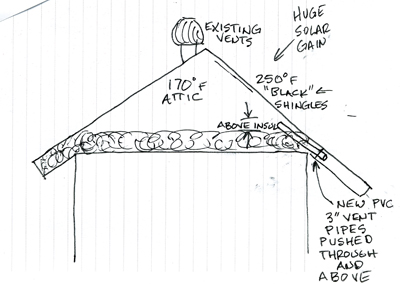magickaldan
New Member
You can't just hose off limescale deposits from misting, unfortunately. It's hard and insoluble and only a light amount is needed to reduce the cooling fin efficiency. Mist does not result in "distilled" water, all the minerals are conveyed in the droplets and generally deposit out when converted from droplets to vapor. Very little will manifest as a deposit on the misting head. Droplets are millions of molecules held together with surface tension which will contain all the minerals present in the tap water, vapor is always single molecules of H2O suspended in air. Vapor cannot hold any calcium or iron or whatever's in the water, calcium and iron is insoluble in air. So wherever it converts from mist to vapor is where the cooling happens and also where the minerals get left. That'll probably be around the fan and condenser, and only at the misting nozzle to a lesser extent.
A gallon of H2O provides about 8700 BTU of cooling when it evaporates. A 2000sq ft house rejects about 48000BTU. But the problem here is that a properly functioning condenser will already cool the return line to close to ambient. Now if you had ONE condenser which cools the coolant down to near-ambient, blowing all 48000BTU out right there, then a second evaporatively cooled condenser which gets it slightly cooler than ambient, little water is required and the gains are significant and you don't need that much water.
However, in attempting to cool a single properly working condenser with mist, you'll need enough mist to cool not only absorb all 48000BTU but get it cooler than ambient. Because it was ALREADY getting it near ambient without your help. That requires a lot of water. Unfortunately, water is often quite expensive in many places which are very hot. So don't dismiss the cost of H2O, it'll actually rapidly overwhelm the gains in electrical usage in my calcs.
Well you shouldn't be cleaning with just water anyways there are certain cleaners designed just for condenser coils and will dissolve anything on the coils restoring them to almost new, and you should use a fin brush to straighten any bent fins out. If done at the beginning of every cooling season your AC won't be working as hard and thus uses less energy. I'm not gonna argue about something that's being done all over the place and works. Here's a link to those interested in it: **broken link removed**
Now this one in the article is a built one made for it but the idea is the same except they went one step farther and went with a reservoir and pump that continually re-pumps the water from the pan of the unit through the nozzles and as the level gets low it replenishes itself from the tap. Basically a standard AC fit with a sump pump and nozzles nothing other than that and the correct sensors to detect when the pressures of the fluid are too low then it shuts off the water.
Cooling a properly working unit down to ambient when ambient is above 95*F just is not enough. Yes it will still work but the problem is it isn't as efficient as running say 70*F refrigerant through the orifice. And if your dew point is low enough that's exactly what evaporating water cooling can do for you. Say one gallon of water removes 8700 Btu, a 3.5 ton unit removes 42,000 btu/hr actually less at higher temperatures. So if you have 42,000/8700=4.8 gallons of water every hour. So if you have it running for the highest temperatures of the day for 8 hrs that equals to less than a 40 gallon tank of water. The average cost of water in the US is between $.001 and $.0025 per gallon so 40gallons*$.0025= $0.10*30days = $3.00/month.
https://www.freepatentsonline.com/5701748.html
The patent calls for a 3.5 ton unit 16 nozzles of 0.6gph which would bring the price of the water up to about $5.76/month * only if the AC was running continuously above 95*F for 8 hrs a day.
Last edited:


